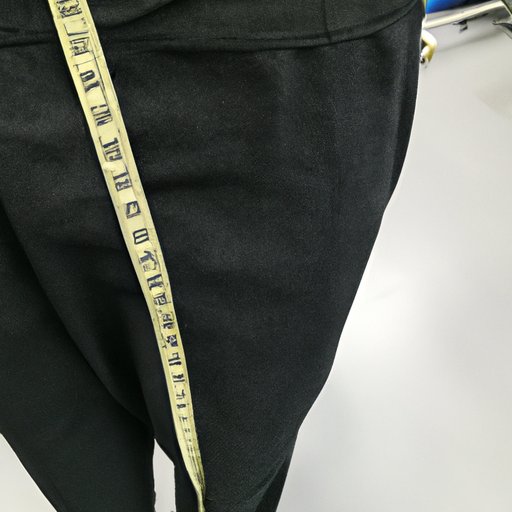
I. Introduction
Choosing the right pant size is crucial for feeling comfortable and confident in any outfit. An ill-fitting pair of pants can ruin your day and your style. Luckily, there are several methods to measure your pant size accurately and find the perfect fit for your body shape and preferences.
II. Using a Measuring Tape
Using a measuring tape is one of the most common methods to measure pant size. Follow these easy steps to get accurate measurements:
1. Start by measuring your waist at its narrowest point, usually located between your lower rib and the top of your hip bone.
2. Measure your hips at the fullest point, usually around the buttocks.
3. Take your inseam measurement by standing straight with your feet shoulder-width apart and measuring from the crotch to the bottom of your ankle bone.
Once you have these measurements, compare them to a size chart to find your standard pant size. However, keep in mind that sizes may vary between brands and styles, so it’s essential to take accurate measurements and adjust as needed.
Use these tips to take the most accurate measurements possible:
– Use a cloth measuring tape, rather than a metal one, to get precise measurements.
– Ask a friend for assistance to ensure the tape is positioned correctly.
– Keep the tape snug against your skin, but not too tight or too loose.
III. Comparing to a Well-Fitting Pair of Pants
If you already have a pair of pants that fit you well, you can use them as a reference to find the right size when buying new pants. Here’s how:
1. Lay your well-fitting pants flat on a surface, smooth out any wrinkles, and measure the waist and inseam.
2. Compare these measurements to the size chart of the new pants you want to buy. If the measurements are similar, it’s likely that the new pants will fit you well.
When trying a new brand or style, keep in mind that sizes may vary, so you may need to adjust your measurements accordingly. You may also have to factor in any differences in fabric stretchiness or pant design.
IV. Visiting a Store and Trying on Different Sizes
Trying on pants in-person is one of the most effective ways to find the perfect fit. Here’s what you need to know:
1. Bring along your measurements or a pair of well-fitting pants as a reference point.
2. Try on several sizes and styles to compare how they fit on your body. Factors to consider include the waistband, length, and fit through the hips and thighs.
3. Walk around, sit down, and move around in the pants to ensure that they are comfortable and fit well in all positions.
4. Don’t be afraid to ask for assistance from store associates to find the right size and style that works for you.
V. Using a Body Scanner
Body scanners are becoming more common in stores and offer a high-tech solution for measuring pant size. Here’s what you need to know:
1. Body scanners use infrared technology to take measurements of your body and provide precise sizing recommendations.
2. Some body scanners require you to stand in a booth or capsule-like structure wearing close-fitting clothing, while others use hand-held devices.
3. While body scanners can provide accurate sizing recommendations, they don’t factor in personal preferences or differences in pant styles and design. Plus, not all stores have body scanners available.
VI. Consulting with a Tailor
If you want a more personalized and expert opinion on your pant size, consider consulting with a professional tailor. Here’s what to expect:
1. A tailor will take detailed measurements of your body and make personalized recommendations based on your preferences and outfit goals.
2. They will also consider factors such as fabric, stretchiness, and pant design to find the best fit for you.
3. While tailor consultations may be more expensive, they can be a worthwhile investment in finding the perfect pants that fit you like a glove.
VII. Factoring in Different Pant Styles
Keep in mind that different pant styles require different sizes and fitting techniques. Here are some examples:
– Skinny jeans or leggings often require a more form-fitting size to avoid sagging or bunching.
– Wide-leg or palazzo pants require a looser and more flowing fit to create the desired silhouette.
– High-waisted or low-rise pants require adjustments in waist and inseam measurements for the perfect fit.
Take your time and research the best fitting techniques for each pant style you’re interested in to find the right size that flatters your body.
VIII. Conclusion
Choosing the right pant size is essential for looking and feeling your best in any outfit. Use a combination of measuring techniques, including using a measuring tape, comparing to well-fitting pants, trying on different sizes in-store, using a body scanner, consulting with a tailor, and factoring in different pant styles, to find the perfect fit for you. Remember to take your time and don’t settle for anything less than the perfect fit.





